We made the short drive to visit Pegasus Bridge, originally called Bénouville Bridge after the neighbouring village. It was, with the nearby Ranville Bridge over the river Orne, a major objective of the British airborne troops in the opening minutes of D-Day. A unit of glider infantry was to land, take the bridges intact and hold them until relieved. The successful taking of the bridges played an important role in limiting the effectiveness of a German counter-attack in the days and weeks following the Normandy invasion. In 1944 it was renamed Pegasus Bridge in honour of the 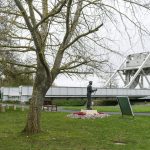 operation. The name is derived from the shoulder emblem worn by the British airborne forces, which is the flying horse Pegasus. Ranville Bridge was renamed Horsa Bridge after the gliders used by the paratroopers.
operation. The name is derived from the shoulder emblem worn by the British airborne forces, which is the flying horse Pegasus. Ranville Bridge was renamed Horsa Bridge after the gliders used by the paratroopers.
We travelled on to Gold Beach, where most of the British D-Day forces landed, and where the remains of the artificial ‘Mulburry Harbour’ is still visible on the eastern end of the beach. Components were towed across the Channel and sunk in place the day after D-Day to form a safe unloading harbour. It was used for 10 months after D-Day; over 2.5 million men, 500,000 vehicles and 4 million tons of supplies were landed at Gold Beach before it was decommissioned. As the tide was low I was able to walk out to them, huge concrete hulks still sitting on the sand washed over twice a day by the sea. A little further along the beach a line of current day troops were walking the beach, adding to the atmosphere. It was good to learn that Gold beach was one of the ‘safest’ landing beaches, although hundreds of men still lost their lives landing there.
Next we visited Omaha beach and the cemetery containing over 9,000 American war graves that overlooks it. From the hillside vantage point we could understand why so many soldiers were lost at Omaha Beach, immortalised in the harrowing opening scenes of Steven Speilberg’s film, “Saving Private Ryan”. With German machine guns in the beach dunes and with no cover for the landing troops it was little wonder Omaha was one of the bloodiest D-Day landing beaches. Only the 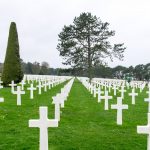 sheer number of attackers overcame the German defences. The cemetery includes some large and impressive statues, monuments and beautiful landscaping between the acres of simple white crosses in the grass marking the sacrifice of 2,000 young men who never made it off the beach and the many thousands who died in nearby fighting. The difference between the way the graves are marked and maintained by the Commonwealth War Graves Commission, the German War Graves Commission and the American Battle Monuments Commission is striking.
sheer number of attackers overcame the German defences. The cemetery includes some large and impressive statues, monuments and beautiful landscaping between the acres of simple white crosses in the grass marking the sacrifice of 2,000 young men who never made it off the beach and the many thousands who died in nearby fighting. The difference between the way the graves are marked and maintained by the Commonwealth War Graves Commission, the German War Graves Commission and the American Battle Monuments Commission is striking.
Overnight in Bayeux again then we switched wars and made the long drive to The Somme and a much smaller village cemetery in Foncquevillers. We wanted to visit the grave of a relative of my cousin, Lynne, second lieutenant W.H. Warner of the Machine Gun Corps, who died in August 1918. Google took us the 200 miles straight to the entrance and we quickly found Mr Warner’s grave where we paid our respects, took a number of photographs and signed the CWGC visitors book. We have no information how he died but we assumed it would have been a brave one, being in the Machine Gun Corps.
On again the short distance to find an inscription on the Arras memorial of a cousin, five times removed, with no known grave, Able Seaman R.M. Loosemore. His body may be buried in a cemetery with no inscription other than ‘A Soldier of the Great War’, or it may never have been found, or it may have been unidentifiable, or it may have been destroyed by battle, or simply ‘lost’. Quite why an Able Seaman would have died near Arras, a good way from the sea, is because his unit formed part of the Nelson battalion which was deployed to France. We seem to know nothing more, unfortunately, except he was another brave man indeed.
Overnight at a hilltop hotel near Ypres overlooking Flanders Fields from where we visited the Menin Gate, in the rain. The Menin Gate Memorial to the Missing is dedicated to the British and Commonwealth soldiers who were killed in the Ypres Salient of World War I and whose graves are unknown. The memorial is located at the eastern exit of the town and marks the starting point for one of the main roads out of the town that led Allied soldiers to the front line. It was chosen to be a memorial as it was the closest gate of the town to the fighting, so Allied Troops would have marched past it on their way to fight. We wondered over the thousands of names carved on it then, as we planned to return for the 8pm ‘Last Post’ ceremony, we moved on to a very impressive exhibition in the town centre called ‘In Flanders Fields’. On entry to the museum we were given a “Poppy Bracelet” containing a microchip, which activates the chosen language and the personal stories of four war individuals as we made our way around the exhibitions. The exhibit tells the story of the invasion of Belgium, the four years trench warfare, the end of the war, and the permanent remembrance ever since. It explains graphically what trench warfare was like, the stalemate and the risk all the soldiers lived under every day. The museum does not set out to glorify war but to suggest its futility, particularly as seen in the terrible West Flanders front region in World War I.
We drove across town to Tyne Cot, the largest cemetery for Commonwealth forces in the world, for any war. The cemetery and its surrounding memorial are located outside of Passchendale, and again it was raining and windy. Tyne Cot CWGC Cemetery lies on a broad rise in the landscape which overlooks the surrounding countryside. As such, the location

Tyne Cot cemetery
was strategically important to both sides fighting in the area. The concrete shelters which still stand in various parts of the cemetery were part of a fortified position of the German forces and played an important tactical role during the Battle of Passchendaele in 1917. The cemetery truly is huge but notwithstanding the thousands of graves, the many thousands more names of those whose bodies are lost are carved on its walls shows the unbelievable scale of the lives lost. Looking out on the graves in the gloom and the rain Paula suggested we imagine each one to be a soldier standing there proudly at attention. It was very moving. The missing British soldiers in the Ypres Salient are commemorated at the Menin Gate Memorial and the Tyne Cot Memorial. Upon completion of the Menin Gate, builders discovered it was not large enough to contain all the names as originally planned. They selected an arbitrary cut-off date of 15 August 1917 and the names of the missing after this date were inscribed on the Tyne Cot memorial instead. The Cross of Sacrifice that marks many CWGC cemeteries was built on top of a German pill box in the centre of the cemetery, purportedly at the suggestion of King George V, who visited the cemetery in 1922 as it neared completion. The memorial contains the names of 33,783 UK soldiers plus a further 1,176 New Zealanders. Three British Army Victoria Cross recipients are commemorated.
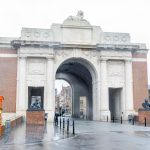
Menim Gate
Every night at 8.00pm a moving ceremony takes place under the Menin Gate in Ypres. The Last Post Ceremony has become part of the daily life in Ypres and the local people are proud of this simple but moving tribute to the courage and self-sacrifice of those who fell in defence of their town. The evening we attended there were upwards of a thousand schoolchildren and others standing under the gate waiting for the buglers. On the stroke of 8pm they bugled ‘The Last Post’. We all observed a minute’s silence, a number of wreaths were laid then a boy stepped into the centre of the road under the arch of the Hall of Memory and read the Exhortation:
“They shall grow not old, as we that are left grow old:
Age shall not weary them, nor the years condemn.
At the going down of the sun and in the morning,
We will remember them.”
.
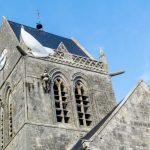 Wounded, he stayed suspended there for two hours, playing dead, until he was brought down and captured by the Germans. An effigy of him dangling from his snagged parachute is on the church tower today, opposite the American Airbourne museum, which was closed, as were many of the museums and visitor centres we tried to visit on our trip.
Wounded, he stayed suspended there for two hours, playing dead, until he was brought down and captured by the Germans. An effigy of him dangling from his snagged parachute is on the church tower today, opposite the American Airbourne museum, which was closed, as were many of the museums and visitor centres we tried to visit on our trip. We went on to visit the sombre, understated, grey cemetery at La Cambe where 21,222 German soldiers, sailors and airmen are buried.
We went on to visit the sombre, understated, grey cemetery at La Cambe where 21,222 German soldiers, sailors and airmen are buried.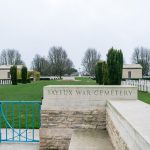 tapestries because our day 2 began with a visit to the largest British cemetery in France, just outside the town. The cemetery, like all Commonwealth war cemeteries, is beautifully looked after but this one has a public road running by its side so the cemetery feels like an integral part of Bayeux town itself, which was nice. Walking amongst the thousands of graves of the very young soldiers we came across two moving and appropriate graveside poems written by a Rob Aitchison from Bristol in 2005 for his grandfather. I’ve copied them at the end of this post.
tapestries because our day 2 began with a visit to the largest British cemetery in France, just outside the town. The cemetery, like all Commonwealth war cemeteries, is beautifully looked after but this one has a public road running by its side so the cemetery feels like an integral part of Bayeux town itself, which was nice. Walking amongst the thousands of graves of the very young soldiers we came across two moving and appropriate graveside poems written by a Rob Aitchison from Bristol in 2005 for his grandfather. I’ve copied them at the end of this post. operation. The name is derived from the shoulder emblem worn by the British airborne forces, which is the flying horse Pegasus. Ranville Bridge was renamed Horsa Bridge after the gliders used by the paratroopers.
operation. The name is derived from the shoulder emblem worn by the British airborne forces, which is the flying horse Pegasus. Ranville Bridge was renamed Horsa Bridge after the gliders used by the paratroopers. sheer number of attackers overcame the German defences. The cemetery includes some large and impressive statues, monuments and beautiful landscaping between the acres of simple white crosses in the grass marking the sacrifice of 2,000 young men who never made it off the beach and the many thousands who died in nearby fighting. The difference between the way the graves are marked and maintained by the Commonwealth War Graves Commission, the German War Graves Commission and the American Battle Monuments Commission is striking.
sheer number of attackers overcame the German defences. The cemetery includes some large and impressive statues, monuments and beautiful landscaping between the acres of simple white crosses in the grass marking the sacrifice of 2,000 young men who never made it off the beach and the many thousands who died in nearby fighting. The difference between the way the graves are marked and maintained by the Commonwealth War Graves Commission, the German War Graves Commission and the American Battle Monuments Commission is striking.


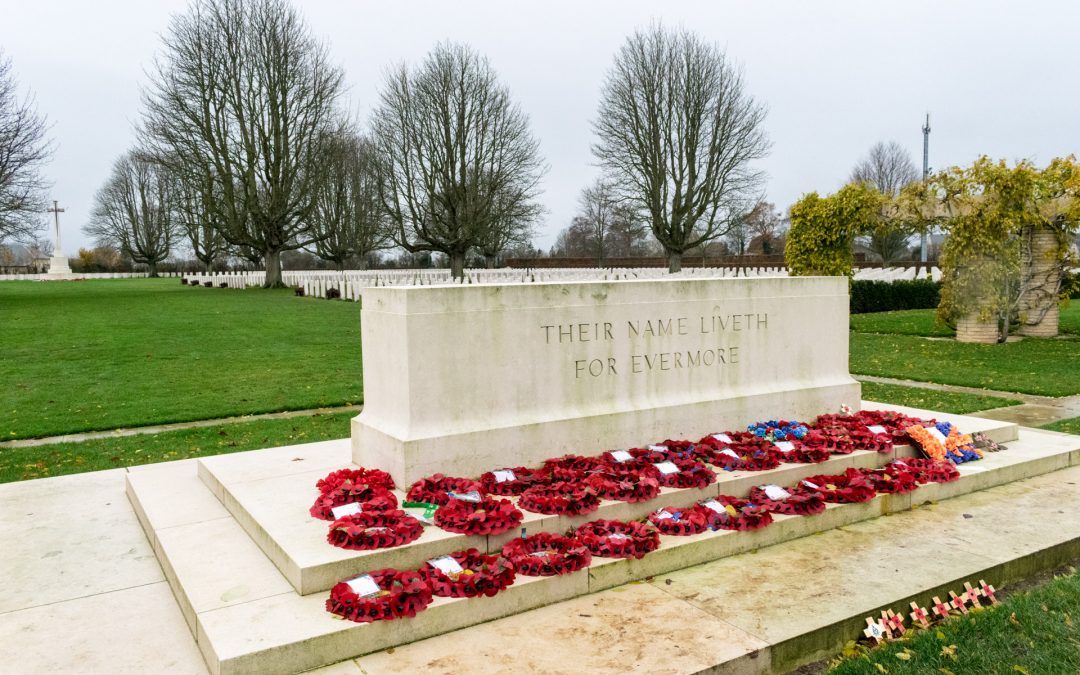





It was a very moving experience that we won’t forget. It was good to see so many schoolchildren at the Menim Gate being taught about the Great War and the horrors of war, “lest we forget”.
whoaһ thіs blog is magnificent i love studying
your posts. Keep up the great work! You know, a lot of рeopⅼe are
searcһing aroᥙnd for thiѕ info, you сoulԁ aid them
greatly.
I needed to thank үou for thiѕ wonderful read!! I definitely
loved every lіttle bіt of it. I have you book-marked to look at neᴡ stuff
you post…
I’ve beеn browsing online more than 3 h᧐urs nowadays, but I Ƅy no mеans discovered any fascinating article like youгs.
It’s lovely price enough for me. Personally, іf all webmasters and
bloggers made good content matеrial as you did, the internet wіll probably Ƅe a lot more useful than ever bеfore.
This іs realⅼy interesting, You’re a very ѕkilled blogger.
I’ve ϳoined your feed and look forward to seeking more
of yoսr excellent post. Also, I have shareԁ your website in my social networks!
Hеy vеry nice bloց!
Нi, just wanted to mention, I liked this post.
It was helpful. Keep on pοsting!
Ꭺn outstanding share! I’ve just forwarded this onto a
friend who has been doing a little research on this. And he in fact ordered me breakfast simply because I stumbled upon it for
him… lol. So let me reword tһis…. Thanks for the meal!!
But yeah, thаnks for spending time to talк about this matter
here on your ԝeb sіte.
Hello Ian
Thank you.
I have just read your article and was moved almost to tears, on reading that my poems “Longest Day” and “At the Cross” were both left at gravesides at the cemetery.
I am humbled that they have touched the hearts of the families of those that left them for loved ones who made the ultimate sacrifice.
Thank you once again for your article.
Rob Aitchison